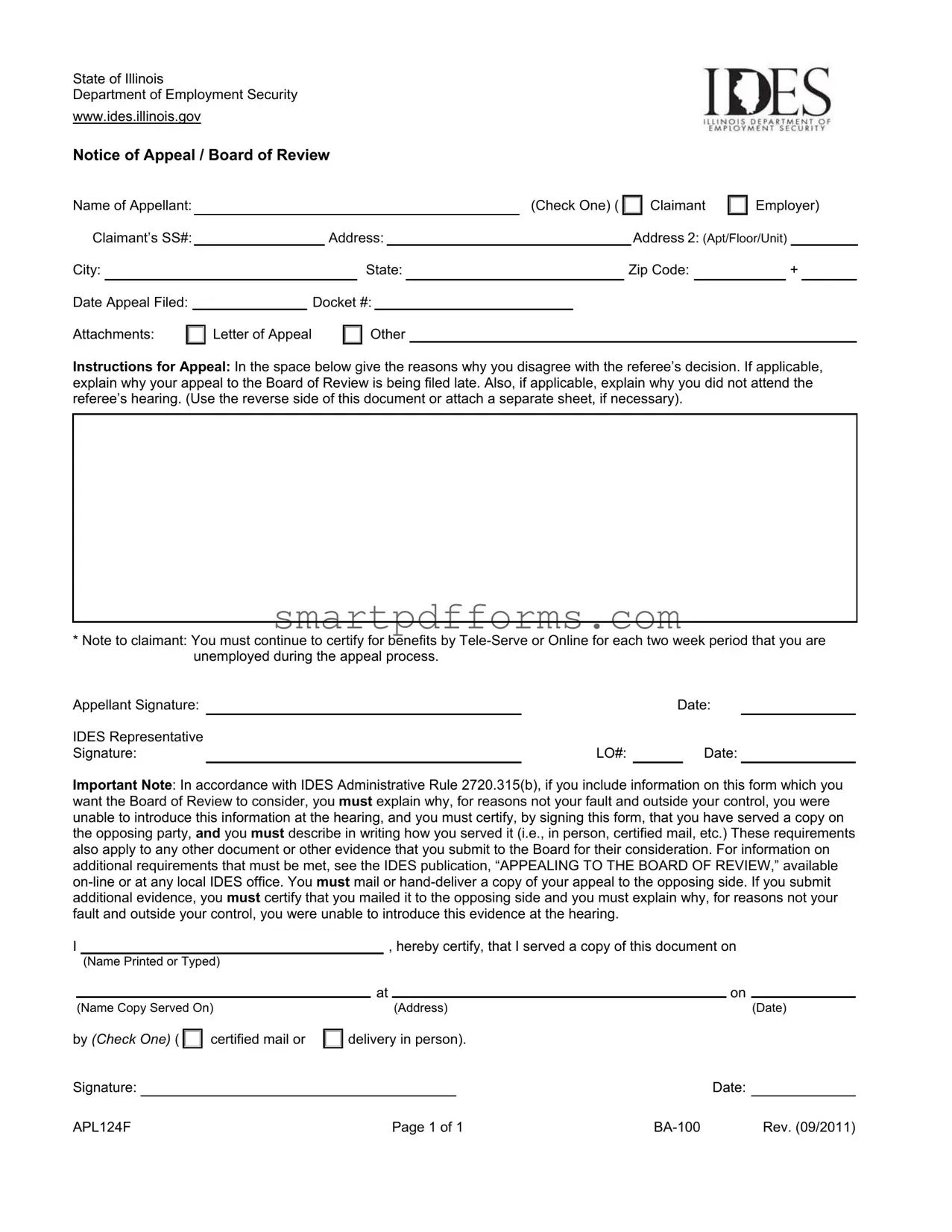State of Illinois
Department of Employment Security
www.ides.illinois.gov
Notice of Appeal / Board of Review
|
|
|
|
|
|
|
|
|
|
|
|
|
|
|
|
|
|
|
|
|
|
|
|
|
|
|
Name of Appellant: |
|
|
|
|
|
|
|
|
|
|
|
|
(Check One) ( |
|
|
Claimant |
|
Employer) |
Claimant’s SS#: |
|
|
|
|
Address: |
|
|
Address 2: (Apt/Floor/Unit) |
|
City: |
|
|
|
|
|
|
|
|
State: |
|
Zip Code: |
|
|
+ |
|
Date Appeal Filed: |
|
|
|
|
Docket #: |
|
|
|
|
|
|
|
|
|
|
|
|
|
|
|
|
|
|
|
|
|
|
|
|
|
|
|
|
|
|
Attachments: |
|
|
Letter of Appeal |
|
|
|
|
Other |
|
|
|
|
|
|
|
|
|
|
Instructions for Appeal: In the space below give the reasons why you disagree with the referee’s decision. If applicable, explain why your appeal to the Board of Review is being filed late. Also, if applicable, explain why you did not attend the referee’s hearing. (Use the reverse side of this document or attach a separate sheet, if necessary).
*Note to claimant: You must continue to certify for benefits by Tele-Serve or Online for each two week period that you are unemployed during the appeal process.
Appellant Signature: |
|
|
Date: |
IDES Representative |
|
|
|
|
Signature: |
|
LO#: |
|
Date: |
Important Note: In accordance with IDES Administrative Rule 2720.315(b), if you include information on this form which you want the Board of Review to consider, you must explain why, for reasons not your fault and outside your control, you were unable to introduce this information at the hearing, and you must certify, by signing this form, that you have served a copy on the opposing party, and you must describe in writing how you served it (i.e., in person, certified mail, etc.) These requirements also apply to any other document or other evidence that you submit to the Board for their consideration. For information on additional requirements that must be met, see the IDES publication, “APPEALING TO THE BOARD OF REVIEW,” available on-line or at any local IDES office. You must mail or hand-deliver a copy of your appeal to the opposing side. If you submit additional evidence, you must certify that you mailed it to the opposing side and you must explain why, for reasons not your fault and outside your control, you were unable to introduce this evidence at the hearing.
I |
|
|
|
|
|
, hereby certify, that I served a copy of this document on |
|
|
|
(Name Printed or Typed) |
|
|
|
|
|
|
|
|
|
|
|
|
|
|
|
|
|
at |
|
|
|
on |
|
|
(Name Copy Served On) |
|
|
|
|
(Address) |
|
|
(Date) |
by (CHECK ONE) ( |
|
certified mail or |
|
delivery in person). |
|
|
|
|
|
|
|
|
Signature: |
|
|
|
|
|
|
|
|
|
Date: |
|
APL124F |
|
|
|
|
|
|
Page 1 of 1 |
BA-100 |
Rev. (09/2011) |

